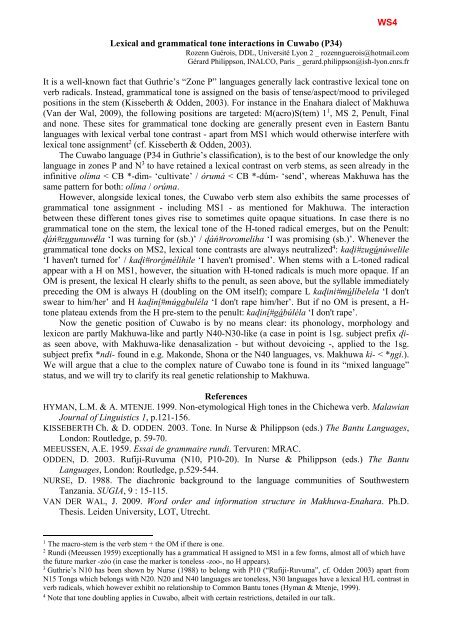here - 5th International Conference on Bantu Languages
here - 5th International Conference on Bantu Languages
here - 5th International Conference on Bantu Languages
You also want an ePaper? Increase the reach of your titles
YUMPU automatically turns print PDFs into web optimized ePapers that Google loves.
WS4<br />
Lexical and grammatical t<strong>on</strong>e interacti<strong>on</strong>s in Cuwabo (P34)<br />
Rozenn Guérois, DDL, Université Ly<strong>on</strong> 2 _ rozennguerois@hotmail.com<br />
Gérard Philipps<strong>on</strong>, INALCO, Paris _ gerard.philipps<strong>on</strong>@ish-ly<strong>on</strong>.cnrs.fr<br />
It is a well-known fact that Guthrie’s “Z<strong>on</strong>e P” languages generally lack c<strong>on</strong>trastive lexical t<strong>on</strong>e <strong>on</strong><br />
verb radicals. Instead, grammatical t<strong>on</strong>e is assigned <strong>on</strong> the basis of tense/aspect/mood to privileged<br />
positi<strong>on</strong>s in the stem (Kisseberth & Odden, 2003). For instance in the Enahara dialect of Makhuwa<br />
(Van der Wal, 2009), the following positi<strong>on</strong>s are targeted: M(acro)S(tem) 1 1 , MS 2, Penult, Final<br />
and n<strong>on</strong>e. These sites for grammatical t<strong>on</strong>e docking are generally present even in Eastern <strong>Bantu</strong><br />
languages with lexical verbal t<strong>on</strong>e c<strong>on</strong>trast - apart from MS1 which would otherwise interfere with<br />
lexical t<strong>on</strong>e assignment 2 (cf. Kisseberth & Odden, 2003).<br />
The Cuwabo language (P34 in Guthrie’s classificati<strong>on</strong>), is to the best of our knowledge the <strong>on</strong>ly<br />
language in z<strong>on</strong>es P and N 3 to have retained a lexical c<strong>on</strong>trast <strong>on</strong> verb stems, as seen already in the<br />
infinitive olíma < CB *-dɩ̀m- ‘cultivate’ / órumá < CB *-dúm- ‘send’, w<str<strong>on</strong>g>here</str<strong>on</strong>g>as Makhuwa has the<br />
same pattern for both: olíma / orúma.<br />
However, al<strong>on</strong>gside lexical t<strong>on</strong>es, the Cuwabo verb stem also exhibits the same processes of<br />
grammatical t<strong>on</strong>e assignment - including MS1 - as menti<strong>on</strong>ed for Makhuwa. The interacti<strong>on</strong><br />
between these different t<strong>on</strong>es gives rise to sometimes quite opaque situati<strong>on</strong>s. In case t<str<strong>on</strong>g>here</str<strong>on</strong>g> is no<br />
grammatical t<strong>on</strong>e <strong>on</strong> the stem, the lexical t<strong>on</strong>e of the H-t<strong>on</strong>ed radical emerges, but <strong>on</strong> the Penult:<br />
ɖáń#zugunuwéla ‘I was turning for (sb.)’ / ɖáń#roromeliha ‘I was promising (sb.)’. Whenever the<br />
grammatical t<strong>on</strong>e docks <strong>on</strong> MS2, lexical t<strong>on</strong>e c<strong>on</strong>trasts are always neutralized 4 : kaɖi#zugúnúwelile<br />
‘I haven't turned for’ / kaɖi#rorómélihile ‘I haven't promised’. When stems with a L-t<strong>on</strong>ed radical<br />
appear with a H <strong>on</strong> MS1, however, the situati<strong>on</strong> with H-t<strong>on</strong>ed radicals is much more opaque. If an<br />
OM is present, the lexical H clearly shifts to the penult, as seen above, but the syllable immediately<br />
preceding the OM is always H (doubling <strong>on</strong> the OM itself); compare L kaɖini#múlíbelela ‘I d<strong>on</strong>'t<br />
swear to him/her’ and H kaɖiní#múgabuléla ‘I d<strong>on</strong>'t rape him/her’. But if no OM is present, a Ht<strong>on</strong>e<br />
plateau extends from the H pre-stem to the penult: kaɖiní#gábúléla ‘I d<strong>on</strong>'t rape’.<br />
Now the genetic positi<strong>on</strong> of Cuwabo is by no means clear: its ph<strong>on</strong>ology, morphology and<br />
lexic<strong>on</strong> are partly Makhuwa-like and partly N40-N30-like (a case in point is 1sg. subject prefix ɖi-<br />
as seen above, with Makhuwa-like denasalizati<strong>on</strong> - but without devoicing -, applied to the 1sg.<br />
subject prefix *ndi- found in e.g. Mak<strong>on</strong>de, Sh<strong>on</strong>a or the N40 languages, vs. Makhuwa ki- < *ŋgi.).<br />
We will argue that a clue to the complex nature of Cuwabo t<strong>on</strong>e is found in its “mixed language”<br />
status, and we will try to clarify its real genetic relati<strong>on</strong>ship to Makhuwa.<br />
References<br />
HYMAN, L.M. & A. MTENJE. 1999. N<strong>on</strong>-etymological High t<strong>on</strong>es in the Chichewa verb. Malawian<br />
Journal of Linguistics 1, p.121-156.<br />
KISSEBERTH Ch. & D. ODDEN. 2003. T<strong>on</strong>e. In Nurse & Philipps<strong>on</strong> (eds.) The <strong>Bantu</strong> <strong>Languages</strong>,<br />
L<strong>on</strong>d<strong>on</strong>: Routledge, p. 59-70.<br />
MEEUSSEN, A.E. 1959. Essai de grammaire rundi. Tervuren: MRAC.<br />
ODDEN, D. 2003. Rufiji-Ruvuma (N10, P10-20). In Nurse & Philipps<strong>on</strong> (eds.) The <strong>Bantu</strong><br />
<strong>Languages</strong>, L<strong>on</strong>d<strong>on</strong>: Routledge, p.529-544.<br />
NURSE, D. 1988. The diachr<strong>on</strong>ic background to the language communities of Southwestern<br />
Tanzania. SUGIA, 9 : 15-115.<br />
VAN DER WAL, J. 2009. Word order and informati<strong>on</strong> structure in Makhuwa-Enahara. Ph.D.<br />
Thesis. Leiden University, LOT, Utrecht.<br />
1 The macro-stem is the verb stem + the OM if t<str<strong>on</strong>g>here</str<strong>on</strong>g> is <strong>on</strong>e.<br />
2 Rundi (Meeussen 1959) excepti<strong>on</strong>ally has a grammatical H assigned to MS1 in a few forms, almost all of which have<br />
the future marker -zóo (in case the marker is t<strong>on</strong>eless -zoo-, no H appears).<br />
3 Guthrie’s N10 has been shown by Nurse (1988) to bel<strong>on</strong>g with P10 (“Rufiji-Ruvuma”, cf. Odden 2003) apart from<br />
N15 T<strong>on</strong>ga which bel<strong>on</strong>gs with N20. N20 and N40 languages are t<strong>on</strong>eless, N30 languages have a lexical H/L c<strong>on</strong>trast in<br />
verb radicals, which however exhibit no relati<strong>on</strong>ship to Comm<strong>on</strong> <strong>Bantu</strong> t<strong>on</strong>es (Hyman & Mtenje, 1999).<br />
4 Note that t<strong>on</strong>e doubling applies in Cuwabo, albeit with certain restricti<strong>on</strong>s, detailed in our talk.


